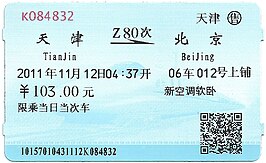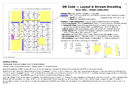[Excerpts]
QR Code (abbreviated from Quick Response Code) is the trademark for a type of matrix barcode (or two-dimensional code) first designed for the automotive industry. More recently, the system has become popular outside the industry due to its fast readability and large storage capacity compared to standard UPC barcodes. The code consists of black modules (square dots) arranged in a square pattern on a white background. The information encoded can be made up of four standardized kinds ("modes") of data (numeric, alphanumeric, byte/binary, Kanji), or through supported extensions, virtually any kind of data.[1]
- 2 Standards
- 3 Uses
- 4 Design
- 5 License
- 6 Variants
- 7 Risks
- 8 See also
- 9 References
- 10 Bibliography
- 11 External links
QR Codes storing addresses and Uniform Resource Locators (URLs) may appear in magazines, on signs, on buses, on business cards, or on almost any object about which users might need information. Users with a camera phone equipped with the correct reader application can scan the image of the QR Code to display text, contact information, connect to a wireless network, or open a web page in the telephone's browser. This act of linking from physical world objects is termed hardlinking or object hyperlinking. QR Codes may also be linked to a location to track where a code has been scanned. Either the application that scans the QR Code retrieves the geo information by using GPS and cell tower triangulation (aGPS) or the URL encoded in the QR Code itself is associated with a location.[12]
In June 2011, the Royal Dutch Mint (Koninklijke Nederlandse Munt) issued the world's first official coin with a QR Code to celebrate its 100 years of existence of its current building and premises. The coin was able to be scanned by a smartphone and link to a special website with contents about the historical event and design of the coin[13]. This was the first time of a QR code used on currency.
Use in mobile operating systems
QR Codes can be used in Google's mobile Android operating system using Google Goggles or 3rd party barcode scanners. QR Codes can be used in iOS devices [iPhone/iPod/iPad] via 3rd party barcode scanners. The browser supports URI redirection, which allows QR Codes to send metadata to existing applications on the device. Nokia's Symbian operating system features a barcode scanner which can read QR Codes,[14] while mbarcode[15] is a QR Code reader for the Maemo operating system. In the Apple iOS, a QR Code reader is not natively included, but more than fifty paid and free apps are available with both scanning capabilities and hard-linking to URI. Google Goggles is also available for iOS. With BlackBerry devices, the App World application can natively scan QR Codes and load any recognized Web URLs on the device's Web browser. Windows Phone 7.5 is able to scan QR Codes through the Bing search app. They can also be used on the Nintendo 3DS.There are a number of websites that provide QR Code decoding. The lack of functioning tools for decoding from image files or webcams within either the MacOS or Linux PC-based operating systems make this standard unpalatable as a data-backup method for storing private data, such as passwords or encryption keys.
Uses in retail
Recently there has been a move away from traditional magnetic card, stamp or punchcard based schemes to QR code based loyalty programs.[16] One prominent example is the US-based Punchd, which became part of Google in 2011.[17] Others, like MazeCard,[18] have offered similar applications of QR codes in other continents.
URLs
URLs aided marketing conversion rates even in the pre-smartphone era, but during those years faced several limitations: the ad viewer usually had to type the URL, and often did not have a web browser in front of them at the moment they viewed the ad. The chances were high that they would forget to visit the site later, not bother to type a URL, or forget what URL to type. Friendly URLs decreased these risks but did not eliminate them. Some of these disadvantages to URL conversion rates are fading away now that smartphones are putting web access and voice recognition in constant reach. Thus an advert viewer need only reach for their phone and speak the URL, at the moment of ad contact, rather than remember to type it into a PC later.
QR Code Virtual Stores
During the month of June 2011, according to one study, 14 million mobile users scanned a QR Code or a barcode. Some 58% of those users scanned a QR or bar code from their home, while 39% scanned from retail stores; 53% of the 14 million users were men between the ages of 18 and 34.[19] The use of QR Codes for "virtual store" formats started in South Korea,[20] and Argentina,[21] but is currently expanding globally.[22] Big companies such as Walmart, Procter & Gamble and Woolworths have already adopted the Virtual Store concept.[23]Design
Storage
The amount of data that can be stored in the QR Code symbol depends on the datatype (mode, or input character set), version (1,...,40, indicating the overall dimensions of the symbol), and error correction level. The maximum storage capacities occur for 40-L symbols (version 40, error correction level L), and are as follows (where character refers to individual values of the input mode/datatype, as indicated):[3][24]| Numeric only | Max. 7,089 characters (0, 1, 2, 3, 4, 5, 6, 7, 8, 9) |
| Alphanumeric | Max. 4,296 characters (0–9, A–Z [upper-case only], space, $, %, *, +, -, ., /, :) |
| Binary/byte | Max. 2,953 characters (8-bit bytes) (23624 bits) |
Risks
Malicious QR Codes combined with a permissive reader can put a computer's contents and user's privacy at risk. This practice is known as "attagging", a portmanteau of "attack tagging".[37] They are easily created and can be affixed over legitimate QR Codes.[38] On a smartphone, the reader's many permissions allow use of the camera, full Internet access, read/write contact data, GPS, read browser history, read/write local storage, and global system changes.[39][40][41]
Risks include linking to dangerous web sites with browser exploits, enabling the microphone/camera/GPS, and then streaming those feeds to a remote server, analysis of sensitive data (passwords, files, contacts, transactions),[42] and sending email/SMS/IM messages or DDOS packets as part of a botnet, corrupting privacy settings, stealing identity,[43] and even containing malicious logic themselves such as JavaScript[44] or a virus.[45][46] These actions could occur in the background while the user is only seeing the reader opening a seemingly harmless web page.[47] In Russia, a malicious QR Code caused phones that scanned it to send premium texts at a fee of US$6 each.[37]
See also
Variants
Micro QR Code is a smaller version of the QR Code standard for applications with less ability to handle large scans. There are different forms of Micro QR Codes as well. The highest of these can hold 35 numeric characters.
Standard QR Code is the QR code standard for applications that possess the ability to handle large scans. A standard QR Code can contain up to 7,089 characters, though not all QR readers can accept that much data.
Custom or artistic QR codes are standard QR codes that have been modified for aesthetic purposes or to make it easier for people to recognize a brand. Many companies use different design techniques to help their code stand out among the crowd. These techniques include: adding color, shapes and various techniques such as round or pointed edges.
Here are some sample custom QR Codes:












 LibreOffice
LibreOffice Firefox
Firefox
No comments:
Post a Comment